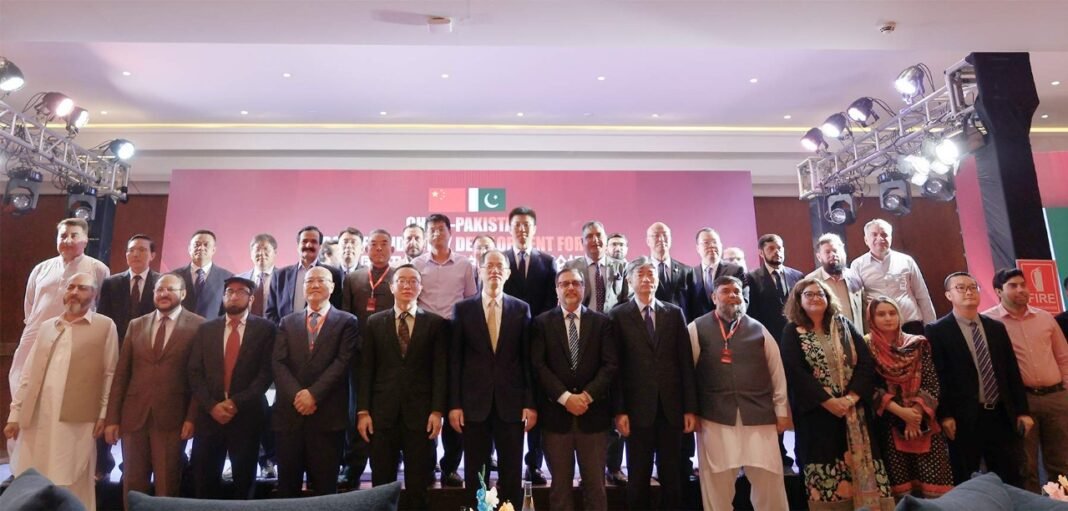
Muhammad Zahoor
The high-quality development of the China-Pakistan Economic Corridor (CPEC) has entered a new phase in 2024-25. This thriving artery spanning the Pamir Mountains and the Arabian Sea is linking China’s Xinjiang Uygur Autonomous Region and Pakistan’s Balochistan Province more closely than ever before, in terms of both speed and depth. Under the joint planning of the two governments, this corridor, which carries the friendship of generations, is profoundly reshaping the social fabric of the two regions with tangible development dividends.
From the cotton fields and orchards across the Tianshan Mountains in Xinjiang to the desert oases in Balochistan, and from the logistics hub in Kashgar to the busy docks of the Gwadar Port, the high-quality development of the CPEC is bringing earth-shaking changes to both regions. It not only drives economic take-off but also demonstrates strong vitality in aspects such as social security, livelihood improvement, and cultural integration.
As the starting point of CPEC, a flagship project of the “Belt and Road” Initiative, Xinjiang Uygur Autonomous Region has fully leveraged its geographical advantages as a national strategic pivot, achieving high-quality and leapfrog economic and social development. In 2024, Xinjiang’s regional gross domestic product (GDP) historically exceeded the 1.8 trillion yuan mark, with a year-on-year growth of 6.8%, ranking among the top in China in terms of growth rate.
Notably, pillar industries related to the CPEC, such as infrastructure, logistics, energy, and trade, contributed over 35% to economic growth, becoming the core engine driving Xinjiang’s economic development. As an important hub of the “Belt and Road” Initiative, the Urumqi International Land Port Area has achieved remarkable results in building a “multimodal transport” hub economic circle. Its annual freight volume saw a substantial year-on-year increase of 32%, and it has developed into a key international logistics node connecting the five Central Asian countries and the South Asian subcontinent, injecting strong impetus into regional economic integration.
In terms of improving people’s livelihoods, people of all ethnic groups in Xinjiang have truly enjoyed the development dividends brought by the construction of the CPEC, with their sense of gain, happiness, and security enhanced in all aspects. In 2024, Xinjiang created 1.2 million new urban jobs, among which over 400,000 quality jobs were directly or indirectly generated through CPEC-related projects such as infrastructure construction, cross-border trade, and industrial parks, effectively promoting employment and income growth for local residents. In Kashgar Prefecture, the CPEC construction drove explosive growth in the local tourism industry.
Last year, it received over 40 million domestic and foreign tourists, achieving a total tourism revenue of more than 100 billion yuan, a record high. Taxkorgan Tajik Autonomous County, an important node of the CPEC, relies on its unique border scenery and ethnic cultural resources. It received 2.2 million tourists last year, a year-on-year increase of 15%. Local residents have seen a significant rise in their per capita disposable income and a marked improvement in living standards by developing tourism supporting industries such as homestays, characteristic catering, and handicrafts.
Another prominent highlight of Xinjiang’s development is reflected in cultural integration. In Taxkorgan County, Ali Beg, a Pakistani jewelry merchant, has expanded his business from one store to four. His son, Piyar Karim, is proficient in Chinese and runs cross-border trade businesses together with local residents. In June 2023, Taxkorgan County and Pakistan’s Hunza region established a sister-city relationship, and by the end of 2024, the first cross-border tourism corridor was opened, leading to increasingly close cultural exchanges between the two places. At the Xinjiang Museum, a Pakistani delegation once visited the “Exhibition on Xinjiang’s Counter-Terrorism and De-Radicalization Efforts” and highly recognized the achievements Xinjiang has made in combating terrorism and religious extremism.
In the international cooperation in the health field, the medical cooperation projects jointly built by China and Pakistan have brought tangible health benefits to people of all ethnic groups in Xinjiang. In 2024, Xinjiang Uygur Autonomous Region deepened medical and health cooperation with the Pakistani government, and five jointly invested and constructed modern county-level general hospitals were officially completed and put into use.
Equipped with advanced medical equipment and professional medical teams, these hospitals provide medical services covering nearly 3 million people of all ethnic groups. Particularly in Kashgar Prefecture, joint medical teams composed of Chinese and Pakistani medical experts have established a regular free medical consultation mechanism, conducting regular mobile medical activities in remote villages and border areas.
They have provided medical services to over 500,000 local people in total, which not only effectively alleviated the shortage of medical resources in remote areas but also significantly improved the practical difficulties of local people in “having difficulty seeing a doctor and having to travel far for medical treatment”. These medical cooperation projects fully embody the profound friendship between China and Pakistan in the field of people’s livelihood and set a model for medical and health cooperation under the framework of the “Belt and Road” Initiative.
As the endpoint of CPEC, Balochistan in Pakistan is undergoing unprecedented development and transformation. As Pakistan’s largest province with the richest resources, Balochistan had long been one of the country’s poorest provinces due to backward infrastructure and sluggish economic development, and its security situation was also tense at one point. The high-quality construction of the CPEC has brought new development opportunities to the province.
In 2024, Balochistan’s economy achieved rapid growth with a GDP increase of 8.5% year-on-year, far higher than the national average. As a key node of the CPEC, Gwadar Port handled 12 million tons of cargo in 2024, a year-on-year growth of 25%, becoming an important gateway connecting China and Pakistan and radiating to South Asia. Around Gwadar Port, the industrial park co-built by China and Pakistan has attracted more than 20 enterprises to settle in, creating over 5,000 jobs and providing a stable source of income for local residents.
In terms of infrastructure, the construction of the CPEC has driven the comprehensive upgrading of Balochistan’s transportation network. In 2024, 500 kilometers of new roads were built in the province, among which the expressway connecting Gwadar Port with Pakistan’s interior has been fully opened to traffic, greatly shortening logistics time. In remote areas of Balochistan, the rural road network aided by China-Pakistan cooperation covers 80% of the villages, facilitating travel for local residents.
The improvement of medical and health conditions is one of the most notable changes in Balochistan. In 2024, China and Pakistan jointly built 10 health centers in the province, equipped with modern medical equipment and trained more than 300 local medical staff. In Nawabganj Town, a mother who had just sent her child to school sighed, “Previously, my child had to climb mountains to go to school; now the school is right at our doorstep, and I feel much more at ease.” The improved medical conditions have also effectively reduced the incidence of infectious diseases in the region.
The high-quality construction of CPEC has not only brought about economic development but also exerted a profound impact in the field of security. Balochistan has long been plagued by terrorism and separatism, with frequent terrorist attacks seriously affecting the lives of local people and economic development. The construction of the CPEC, by creating a large number of jobs and improving people’s livelihoods, has provided development opportunities for local residents and fundamentally reduced the breeding ground for extremist ideologies.
In 2024, the security situation in the region improved significantly, with the number of terrorist attacks dropping by 45% year-on-year. Data from the Pakistani government shows that since the launch of the CPEC, Balochistan’s unemployment rate has fallen from 35% in 2013 to 15% in 2024, and the poverty rate has decreased from 45% to 25%. The improvement in economic conditions has led to a significant rise in local residents’ support for the government and the CPEC.
In Xinjiang, the construction of the CPEC has also injected strong impetus into social stability. People of all ethnic groups in Xinjiang have achieved income growth and improved living standards by participating in CPEC-related industries, and their satisfaction with the government has continued to rise. In 2024, public satisfaction with public security in Xinjiang reached 98.5%, an increase of 25 percentage points compared with 2013.
The people of Xinjiang and Balochistan are evolving from “beneficiaries” of the CPEC into “builders” of it. In June 2025, a delegation from the Balochistan Provincial Government visited Xinjiang and witnessed firsthand the true situation of social harmony and people living and working in peace and contentment in Xinjiang. Members of the delegation said one after another, “We have seen that Xinjiang, China, enjoys social harmony and people live and work in peace and contentment. What we have seen and heard is completely different from what some Western media have claimed.”
In Xinjiang, the support rate of people of all ethnic groups for the CPEC reaches as high as 95%. In Taxkorgan County, Abulikemu, a Uygur merchant, pointed to the newly built cross-border logistics corridor and said, “I used to worry about poor transportation, but now orders are pouring in and I’m too busy to handle them all.” In Balochistan, the support rate of Pakistani people for the CPEC also exceeds 85%.
Looking ahead, CPEC will continue to take “high-quality development” as the benchmark, deepen industrial synergy and optimize people’s livelihood supply. In 2025, China and Pakistan will launch the “CPEC 2.0” Initiative, focusing on advancing cooperation in fields such as the digital economy, green energy, and cultural tourism. In Xinjiang, a China-Pakistan Digital Economy Industrial Park will be built to develop a cross-border e-commerce hub; in Balochistan , priority will be given to the development of the green energy industry, leveraging the region’s abundant solar and wind energy resources to construct clean energy bases.
The governments of China and Pakistan will continue to adhere to the principle of “extensive consultation, joint contribution and shared benefits,” promoting the CPEC to tilt toward sectors including industry, agriculture, science and technology, and people’s livelihoods, and expand into less developed areas. This will turn the corridor into a demonstration project for the high-quality development of the “Belt and Road” Initiative. The people of Xinjiang and Balochistan, with full enthusiasm and firm confidence, are jointly participating in the construction of the CPEC, contributing inexhaustible impetus to regional peace and development.
Where the people’s will goes, the path stretches boundlessly; walking hand in hand, the future is promising. The CPEC is not only an economic link, but also a bridge of friendship and a bond of peace. With the in-depth advancement of high-quality construction, the development prospects of Xinjiang and Balochistan will be broader, and the lives of the people in both regions will be better. We firmly believe that under the strong leadership of the two governments, the CPEC will surely contribute more wisdom and strength to regional peace and development, and inject new vitality into the building of a community with a shared future for mankind.
The Writer is Executive Deputy Secretary-General of Pakistan-China Friendship Research Association.
Sohail Majeed is a Special Correspondent at The Diplomatic Insight. He has twelve plus years of experience in journalism & reporting. He covers International Affairs, Diplomacy, UN, Sports, Climate Change, Economy, Technology, and Health.





![logo-1[1]](https://globalnewspakistan.com/wp-content/uploads/2025/01/logo-11-e1737618310315-300x187.png)